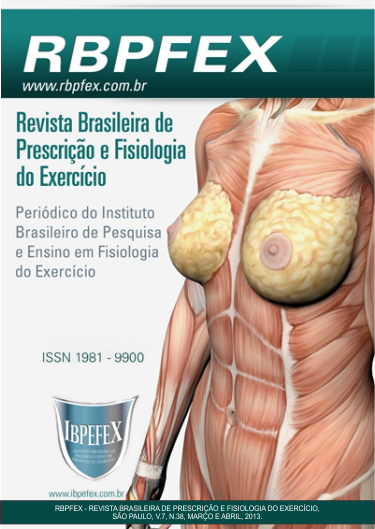Excess post-exercise oxygen consumption (EPOC) of elderly women submitted to a circuit resistance training session
Abstract
The present study aimed to determine the magnitude and duration of EPOC after a session of resistance training in older adults. The were volunteers were six women, mean age 63.8 ± 2.14 years, mean height of 153 ± 5,2 cm, body mass 56.6 ± 5.3 kg and BMI of 24.55 ± 3.16 kg / m², with experience of at least 6 months in resistance training. The volunteers were subjected to a session of resistance training in the method of circuit, consisting of 12 exercises, with one round and intensity of 50% 1RM, performing 20 repetitions submaximal, with an interval of 1 minute rest between each exercise. EPOC was observed only for a period of up to 4 minutes after the training session, with the largest magnitude was observed until about 2 minutes after the training session. In conclusion, resistance exercise with low intensity and low volume, performed under the method to circuit in elderly individuals, promotes an EPOC effect of little magnitude and duration.
References
-American College of Sports Medicine. Appropriate Physical Activity Intervention strategies for weight loss and prevention of weight regain for adults. Medicine Science Sports Exercise. Vol. 41. Núm. 2 p. 459-471. 2009.
-Bálsamo, S.; Simão, R. Treinamento de força para osteoporose, fibromialgia, diabetes tipo2, artrite reumatóide e envelhecimento. 2ª edição. Phorte. p. 25. 2005.
-Borsheim,E.;Bahr,R. Effect of exercise intensity, duration and mode on post-exercise oxygen consumption. Sports Med. Vol. 33. Núm. 14. p. 1037-60. 2003.
-Campos, M.A. Musculação: diabéticos, osteoporóticos, idosos, crianças, obesos. 4ª. edição. Rio de Janeiro. Sprint. p. 79-159. 2008
-Castinheiras Neto, A.G.; Silva, N.L; Farinatti, P.T.V. Influência das variáveis do treinamento contra-resistência sobre o consumo de oxigênio em excesso após o exercício: uma revisão sistemática. Revista Brasileira de Medicina do Esporte. Vol. 15. Núm. 1. p. 71. 2009.
-Costa, R.F.; Fisberg, M. Atividade física e obesidade. In: Gorgatti, M.G.; Costa, R.F. Atividade adaptada: qualidade de vida para pessoas com necessidades especiais. 2ª edição. Manole. p. 464-484. 2008.
-Dâmaso, A.R. Obesidade. Rio de Janeiro. Guanabara Koogan. p. 1-35. 2003.
-Fleck, S. J.; Figueiredo Junior, A. Treinamento de força para fitness e saúde. São Paulo. Phorte. 2002. p. 1-13.
-Foureaux, G.; Pinto, K. M.C.; Damaso, A. Efeito do consumo excessivo de oxigênio após exercício e da taxa metabólica de repouso no gasto energético. Revista Brasileira de Medicina do Esporte. Vol. 12. Núm. 6. p. 395. 2006.
-Haltom, R.W.; Kraemer, R.R.; Sloan, R.A.; Hebert, E.P.; Frank, K.; Tryniecki, J.L. Circuit weight training and its effects on excess postexercise oxygen consumption. Medicine Science in Sports and Exercise. Vol. 31. p. 1613-1618. 1999.
-Izquierdo, M.; Ibañez, J.; Gonzáles-Badillo; Hakkinen, K; Ratames, N.A.; Kraemer, W.J.; French, D.N.; Eslava, J.; Altadill, A.; Asiain, X.; Gorostiaga, E.M. Differential effects od strength training to failure versus not to failure on hormonal responses, strength, and muscle power gains. Journal Apllied Physiol. Vol. 100. p. 1647-1656. 2006.
-Lira, F.S.; e colaboradores. Consumo de oxigênio pós-exercicios de força e aeróbio: efeito da ordem de execução. Revista Brasileira de Medicina do Esporte. Niterói. Vol.13. Núm. 6. p. 404. 2007.
-Lopes, M.H.; Navarro, A.C.O exercício de força em obesos promove o emagrecimento. TCC do Programa de pós-graduação Lato Sensuda Universidade Gama Filho em Fisiologia do Exercício: Prescrição do Exercício. Belo Horizonte. 2008.
-Marsola, T.S.; Carvalho, R.S.T.; Robert-Pires, C.M. Relação entre peso levantado em teste de 1RM e peso corporal de homens sedentários no exercício supino reto. Revista Brasileira de Prescrição e Fisiologia do Exercício. Vol. 5. Núm. 30. p. 484-489. 2011. Disponível em: http://www.rbpfex.com.br/index.php/rbpfex/article/view/387/371
-Meirelles, C.M.; Gomes, P.S.C. Efeitos agudos da atividade contra-resistência sobre o gasto energético: revisitando o impacto das principais variáveis. Revista Brasileira de Medicina do Esporte. Vol. 10. Núm. 2. p. 127. 2004.
-Novaes, J.S. Ciência do treinamento dos exercícios resistidos. São Paulo. Phorte. p. 167. 2008.
-Robert-Pires, C.M.; Santos, C.F.; Menezes, H.J. Verificação do EPOC em sessão de exercício de baixa intensidade sob o método de circuito. EFDeportes Revista Digital. Ano 16. Núm. 157. 2011.
-Santos, B.V.; Santos, M.N.; Maia, M.P. Os benefícios da atividade física regular para pessoas com obesidade. Revista Educação Física UNICAMP. Vol. 7. Núm. 3. p. 105. 2009.
-Speretta, G.F.F.; Magosso, R.F.; Pereira, G.B.; Leite, R.D.; Domingos, M.M.; Robert-Pires, C.M.; Urtado, C.B.; Assumpção, C.O.; Prestes, J. Efeito do intervalo entre as séries sobre o volume de repetições no método piramidal crescente. Revista Brasileira de Prescrição e Fisiologia do Exercício. Vol. 3. Núm. 14. p. 118-123. 2009. Disponível em: http://www.rbpfex.com.br/index.php/rbpfex/article/view/152/155
-Thornton, M. K.; Potteiger, J. A. Effects of resistance exercise bouts of different intensities but equal work on EPOC. Medicine Science in Sports and Exercise. Vol. 34. Núm. 4. p. 715-722. 2002.
Authors who publish in this journal agree to the following terms:
- Authors retain the copyright and grant the journal the right of first publication, with work simultaneously licensed under the Creative Commons Attribution License BY-NC which allows the sharing of the work with acknowledgment of the authorship of the work and initial publication in this journal.
- Authors are authorized to enter into additional contracts separately for non-exclusive distribution of the version of the work published in this journal (eg, publishing in institutional repository or book chapter), with acknowledgment of authorship and initial publication in this journal.
- Authors are allowed and encouraged to post and distribute their work online (eg, in institutional repositories or on their personal page) at any point before or during the editorial process, as this can bring about productive change as well as increase impact and impact. citation of published work (See The Effect of Free Access).






